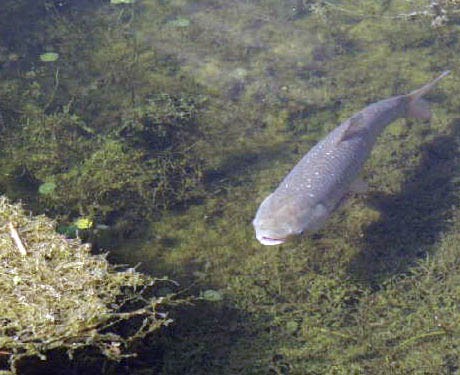The other Asian carp: Why grass carp deserve more attention
Bighead and silver carp have been at the center of the Asian carp controversy for several years, but another Asian carp could have serious impacts on Great Lakes waters.
The term “Asian carp” conjures images of leaping silvery fish as news stories, online videos, and photographs depicting the jumping behavior of silver carp have become entrenched in popular culture. These stories and images have generated widespread support for the prevention of the spread of invasive species into in the Great Lakes. Bighead carp also fall under the “Asian carp” moniker and pictures of 90-pound plus bighead carp caught in U.S. waters have underscored their voracious appetite for plankton.
While the plankton-eating bighead and silver carp have become a focal point for attempts to keep invasive species out of Great Lakes waters, another Asian carp species has the potential to damage Great Lakes environments in very different ways. Bighead and silver carp eat the same plankton that native baitfish and larval gamefish eat; however, the grass carp eats plants that provide habitat for fish and food for waterfowl.
 Grass carp were brought into U.S. waters to control aquatic plant growth and stocked (legally and illegally) in ponds, canals, impoundments and lakes. Their effectiveness as a plant management tool has met with mixed success. There is no doubt that grass carp eat huge quantities of aquatic plants. Grass carp consume from 20 to 100% of their body weight in vegetation per day depending on their size and water temperature, although they stop feeding at temperatures below 50°F.
Grass carp were brought into U.S. waters to control aquatic plant growth and stocked (legally and illegally) in ponds, canals, impoundments and lakes. Their effectiveness as a plant management tool has met with mixed success. There is no doubt that grass carp eat huge quantities of aquatic plants. Grass carp consume from 20 to 100% of their body weight in vegetation per day depending on their size and water temperature, although they stop feeding at temperatures below 50°F.
Grass carp do not eat all plants with equal enthusiasm, though. In Michigan, one of our most troublesome aquatic weeds is the non-native Eurasian watermilfoil. This milfoil is low on the menu for grass carp, which will eat all the desirable native plants before turning to the nuisance milfoil. This means that grass carp can only control milfoil when they are so abundant that they remove virtually all aquatic plant growth – a disastrous proposition for waterfowl that feed on aquatic vegetation and many native fish species that use vegetation as nursery or spawning habitat.
Another problem is that grass carp do not digest everything they ingest. Very few fish species have the ability to subsist on aquatic plants, but the grass carp has uniquely adapted teeth in its throat that help to shred plant material and an extremely long intestinal tract to aid in absorption of nutrients. Even so, much of what comes out the back end of a grass carp is still green and full of nutrients that stimulate the growth of algae.
This means that grass carp can turn a lake with clear water and a healthy community of aquatic plants into a murky-water environment devoid of rooted plants. I personally have witnessed lakes stocked with such a high density of grass carp that they resorted to sticking their heads out of the water and feeding on grasses at the lake’s edge because no submerged aquatic plants were left in the lake.
While stocking sterile grass carp at reasonable densities might be an acceptable way to reach management goals on tightly controlled systems in other watersheds, the prospect of such a voracious fish reproducing naturally in Great Lakes tributaries is cause for concern. Like other Asian carp, grass carp are river spawners that often use lakes or lake-like environments connected to large rivers for feeding. This means that the marshes, bays, drowned river mouth lakes and bayous of the Great Lakes basin could be at risk if grass carp establish breeding populations.
Anyone who enjoys fishing for panfish in west Michigan bayous, casting for bass in Lake Erie marshes or duck hunting on Saginaw Bay should consider what effects grass carp might have on these habitats. It is often assumed that most grass carp found in rivers are sterile fish that escaped from ponds. However, grass carp have been naturally reproducing in the Illinois River since the early 1990s and the same connections that could bring bighead and silver carp into the Great Lakes could provide a pathway for grass carp.
Sources:
USGS Nonindigenous Aquatic Species Database
McKnight, S. K. and G. R. Hepp. (1995). Potential effect of grass carp herbivory on waterfowl foods. Journal of Wildlife Management 59(4):720-727. Retrieved from http://www.jstor.org/pss/3801948



 Print
Print Email
Email

